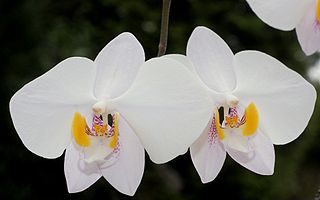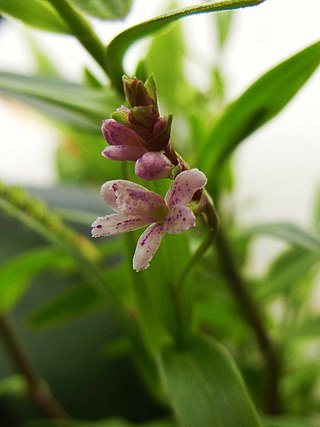
Cattleya is a genus of orchids from Costa Rica south to Argentina. The genus is abbreviated C in trade journals.

Laelia is a small genus of 25 species in the orchid family (Orchidaceae). Laelia species are found in areas of subtropical or temperate climate in Central and South America, but mostly in Mexico. Laelia is abbreviated L. in the horticultural trade.

Phragmipedium kovachii is an orchid species found to be new to science in 2001, native to the Andean cloud forests of northern Peru. A species with terrestrial habit and growing in clumps of several individuals, it displays showy pink to purple flowers up to 20 cm (8 in) wide. It is currently considered a critically endangered species by the IUCN, due to overcollection in the wild.

Phalaenopsis stobartiana, also known as 滇西蝴蝶兰 in Chinese, is a species of epiphytic plant in the family Orchidaceae. It is endemic to Hainan, China. The specific epithet stobartiana refers to William Culley Stobart. The Stobart family were the principal landowners and colliery owners in the 19th century in England.

Oncidium alexandrae, synonyms including Odontoglossum crispum, is an epiphytic orchid in the genus Oncidium. Known as the curled odontoglossum, it is considered by many to be the most beautiful orchid of all but is also one of the most difficult to grow.

Epidendrum compressum is a species of orchid in the genus Epidendrum from wet montane forests of Trinidad, Venezuela, Colombia, Ecuador, Peru and Bolivia.

Epidendrum microphyllum is a species of tropical orchid in the genus Epidendrum with non-resupinate flowers.

Cattleya maxima is a species of orchid in subfamily Epidendroideae found from Ecuador to Peru.

Encyclia adenocaula is a species of epiphytic orchid of light purple flowers, native to forests in Mexico.

Phalaenopsis philippinensis is an endemic species of orchid found from Luzon island in the Philippines.

Epidendrum calanthum is a terrestrial reed-stemmed Epidendrum orchid from the montane Tropical rainforest of Bolivia, Colombia, Ecuador, Peru, Venezuela, and the West Indies.
Epidendrum spruceanum is an epiphytic reed-stemmed Epidendrum orchid native to the Tropical rainforest of Peru, Bolivia, and Brazil.
Epidendrum lanipes is an epiphytic sympodial orchid with spindle-shaped stems native to the montane tropical rainforest of Bolivia, Colombia, Ecuador, and Peru at altitudes ranging from 0.8 to 1.4 km.

Epidendrum coriifolium is a sympodial orchid which grows both terrestrially and epiphytically at altitudes of 1.4—1.7 km in dense forests in Brazil, Ecuador, Mexico, Central America, and Venezuela.

Epidendrum fimbriatum is a terrestrial orchid native to high altitudes (2.2—3.4 km) in Bolivia, Colombia, Ecuador, Peru, and Venezuela.

Psychopsiella is a monotypic genus in the orchid family found only in the state of Rio de Janeiro in Brazil and near Caracas in Venezuela. It grows as an epiphyte in evergreen montane forests at elevations of 800 to 1,500 metres.

Prosthechea citrina, synonym Encyclia citrina, is a species of orchid native to southwest Mexico. It is known as tulip orchid and has a strong lemon fragrance. Its petals are golden yellow with varying degrees of white crenulations in the lip. The plant may be upright or pendant, but the flowers are always pendant. It is also known as the tulip orchid due to its flowers' rounded cup-like shape. It has been referred to for generations as costicoatzontecoxòchitl, meaning "flower in the form of yellow serpent head", by the Nahuas.

Cattleya iricolor is a species of orchid native to the eastern montane forests of Ecuador and Peru.

Encyclia candollei is a species of epiphytic orchid of yellow-brown to reddish flowers, native to Belize, Guatemala and Mexico.
Jejewoodia is a genus of flowering plants belonging to the family Orchidaceae.



















